The vibratory bowl conveyor provides an economical and reliable method of presenting small parts in a given orientation. However控制工程网版权所有, a key weakness of the vibratory bowl feeder is its use of mechanical channels and guides to orient parts. This limits it to handling just one part or one family of similar parts. Loading aerospace fasteners into a press seemed to be ideally suited for automation with a vibratory bowl feeder and a pick-and-place robot, but sorting the 415 parts involved would have r
Recent improvements in the speed, accuracy, and reliability of vision systems made it possible to use a vision sensor to replace channels and guides to deliver a flexible vibratory bowl feederwww.cechina.cn, says Stephen Harris, president of Rixan Associates. The design created the ability to handle a “virtually unlimited number of parts within a certain size rangewww.cechina.cn,” he says.

Feeder presents parts on plenum in lower left of picture. (Parts used in this application cannot be shown, so are replaced by candy bars of similar sizes.
The patent-pending Rixan RFS-1000 flexible vibratory bowl feeder system, which costs about $45,000, provides a 20% improvement in productivity, and frees up one operator for other tasksCONTROL ENGINEERING China版权所有, providing less than a one year return on investment for most users. It uses the vibratory bowl feeder concept to randomly present the parts in the bowl in any orientation. When the vision system views the right part in the right orientation, it stops the feeder and sends the part’s location to a robot, which loads the part into the press.
Here's how it came about. An aerospace manufacturer wanted to automate part picking and placing because of the potential danger involved in having an operator reach into a stamping press. Additionally, the repetitive nature of the task and potential for hand and wrist injury required an operator to take frequent breakswww.cechina.cn, limiting productivity.
Rixan engineers, led by chief technical officer Mark Battisti, de


 在线会议
在线会议 论坛
论坛 专题
专题 工控直播
工控直播 新闻中心
新闻中心 子站
子站 技术
技术 社区
社区


 剑维软件电子半导体行业白皮书有奖下载
剑维软件电子半导体行业白皮书有奖下载 魏德米勒麒麟系列产品赋能本土工业
魏德米勒麒麟系列产品赋能本土工业 Fluke 283 FC 智能万用表震撼来袭
Fluke 283 FC 智能万用表震撼来袭 SugonRI2.0工业编程平台免费有奖试用
SugonRI2.0工业编程平台免费有奖试用 IDEC HR8S系列新一代安全继电器有奖试用活动
IDEC HR8S系列新一代安全继电器有奖试用活动



























